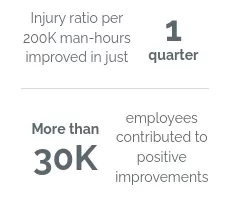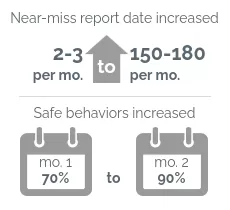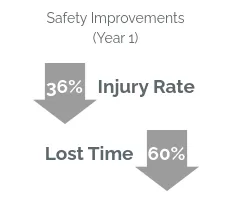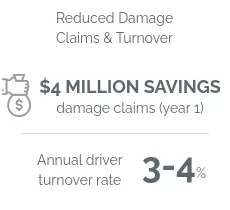



FREE EBOOK: CREATING A CULTURE OF ENGAGEMENT THROUGH BEHAVIORAL SCIENCE
Managing human performance is difficult but when you understand and apply strategies from the science of behavior, you can create an environment where workers become engaged and focused on organizational success. Topics covered include:
- Understand why people do what they do
- Applying the science of behavior, including case examples
- Overcoming other business challenges

Solving Challenges in the Transportation Industry
The transportation industry faces significant challenges. Fuel costs, driver shortages, increased regulations, changes in volume, heightened demand for timely delivery, distracted driving, and increasing traffic congestion to name a few.
All these challenges require quickly adapting strategy and behavior to meet the changing landscape. Managing the human performance component of challenges like these is difficult in any industry, but the significant number of lone workers in transportation adds to the challenge. Managing people who are on the road for hours, days, sometimes longer without opportunities to observe work, discuss work conditions, and provide feedback makes meeting business objectives and handling change more difficult. How can supervisors ensure that workers have the support they need, and do all the things they need to do to meet customer demands, work efficiently, and most importantly, safely?
ADI’s Science-Based Solutions
ADI provides solutions that enable transportation companies to meet these challenges and maximize performance. Behavioral science has been used across industries to improve customer service, quality, productivity, and safety. ADI’s time-tested, evidence-based approach helps create cultures of engagement where all workers are energized and focused on the organization’s success. Engagement is particularly important when the workforce includes lone workers, who often are the face of the company to customers. These workers operate large vehicles in public spaces so they are not only responsible for their own safety, but also the safety of people around them—customers, passengers, pedestrians, and people in other vehicles. Their behavior also directly affects customer service, quality, loss control, and cost. Old school management strategies are not sufficient to create optimal performance in this unique industry.
ADI has been providing behavioral expertise to organizations for more than 40 years. Our science-based solutions can be applied to improve your workplace safety culture, customer service, and operational efficiency. Regardless of whether transportation is your core business or a component of your business, our culture change consultants can help you create a work environment that promotes engagement at all levels through positive, proactive practices.
Client Feedback
Transportation Services
Here are just a few ways ADI supports you in applying sound behavioral principles to motivate and sustain performance.
Client Perspective
Norfolk Southern created a positive workplace safety culture by engaging leaders in a coaching process that reinforced safe practices and addressed at-risk behavior from a scientific perspective.
Industry Spotlight

SAFETY
CULTURE



SAFETY
LEADERSHIP



LONE WORKER &
BEHAVIOR-BASED SAFETY



BEHAVIORAL
LEADERSHIP


LEADERS WHO WANT TO IMPROVE TRANSPORTATION SAFETY MUST READ "SAFE BY ACCIDENT"?
This book reveals how behavioral science can foster a company-wide culture of safety. Authors, Judy Agnew and Aubrey Daniels deliver seven common safety leadership practices that don’t work (and what to do instead) and offer recommendations for positive change.

Common Challenges in Transportation
Need help with human performance challenges in transportation? Here are a few insights from ADI on how to tackle common challenges in transportation:
Positive improvements to driver behavior can be achieved through the effective use of electronic performance monitoring tools. The effectiveness of the tool depends on how the data are used and whether the consequences supporting the behavior change are positive or negative. Read on for two contrasting applications of performance monitoring tools…
Creating a positive safety culture can be one of the most difficult challenges an organization faces. There are seven foundational keys to help guide you through, including eliminating blame for near misses and accidents. Read on for the remaining six keys to a positive safety culture…
Onboard driver behavior monitors are only sensors. These systems need to be configured and deployed as part of a total behavioral management system that provides direct feedback to drivers. While this technology provide valuable observational data for a lone worker, positive reinforcement is still required for sustained behavior change and organizational improvement. Read on to learn the behavioral implications of onboard monitoring systems…
If you want stronger engagement, you need to develop sound relationships. There are many best practices you can apply for building effective relationships that go beyond just being nice. Following through on commitments is one. Read on for other relationship best practices…
Even the most robust transportation safety management systems do not guarantee exceptional safety performance, just as the best driver safety checklists won’t prevent accidents. In this video, Judy Agnew explains what organizations need to do to get employees using safety management tools reliably and accurately. Watch this short video to learn more...
Agility and rapid strategy execution is essential for survival and growth in the transportation industry. If your leadership doesn’t understand behavior from a scientific perspective, you’re leaving your business success to chance. In this video, David Uhl how ADI’s systematic approach to managing human performance can separate you from the competition. Watch this short video to learn more…










